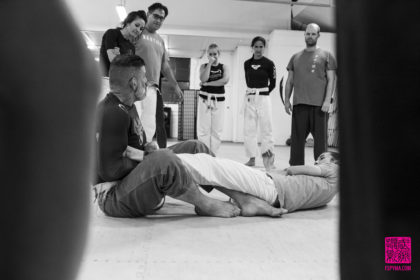
photo by francine schaepper / fspyma.com
When I was fifteen, two guys approached me on the street in New York. They started a classic street hustle – a lot of quick conversation back and forth, building a story for me, finding a way to hook me in emotionally. It happened very quickly and then it was over.
You might not believe it, but it worked. They ended up getting my money. And it was smooth. Don’t misunderstand – this wasn’t a robbery. They didn’t have to fight me for the money. I gave it to them.
I was young, but I remember feeling so ashamed because I couldn’t figure out how they got me…but they got me.
Looking back, I failed to do one major thing – listen to myself. I didn’t understand. At the first sign that something was wrong, I ignored my feelings. Then at the second sign I ignored it. And at the third sign I was starting to think that things were off but by then it was too late.
In situations like these, trouble doesn’t just turn up out of the blue. Instead there is a convergence of points that we keep ignoring and at the end we get caught.
See, this was also one of the most important things I ever learned in Jiu-Jitsu: the idea that submissions are a convergence of techniques.
They are not one isolated moment distinct from all others. They’re causally related to everything that’s come before.
So…what does that mean for us as martial artists?
It gives us a heuristic, a way of understanding where we are at any given moment. We can look at the dots that are connected and see where we’re headed.
In training, it means that we can assess both our own positive opportunities as well as threats we feel.
Think about it like this: for something meaningful to happen, we have to satisfy all of the prerequisites. If we don’t, we lose position and a chance to progress forward.
As in my story above, it’s very easy to sacrifice a valuable position because we fail to connect the dots. I didn’t make the adjustments and I was “out of position”, so I was vulnerable.
In training, when you’re sparring or working with a partner and they’re managing the inside position, or constantly cutting off your movement and boxing you in, this is what’s happening.
It’s up to you to establish an awareness of what is going on so you can respond well and understand where you’re being effective and where you’re not.
To me, this is what great martial arts is. It’s using a principle to gauge how you’re doing and where you are in a complex scenario.
Great martial arts training is not just a few “moves” that get cobbled together. Instead what we’re doing is operating inside of a principle, and when that principle is satisfied the techniques arise without failure.
It’s often a very impressive process, which is one of the reasons we love it. The results arrive as a consequence of our earlier actions in a very effective, very efficient way. Often it’s effortless and it’s beautiful.
When it happens, the art comes alive in a very real way. All points connect properly. And we’re reminded that our best work is about the unifying elements that guide our decisions.
It’s empowering and reassuring and encouraging to know that it’s available when we put attention in the right places.
For more about our larger project of cooperative Jiu-Jitsu and martial arts training, visit the Brooklyn Brazilian Jiu-Jitsu (Brooklyn BJJ) website here.
Contact Gene Dunn here and Brian Glick here.
November 24, 2016 - BJJ News
|| Martial Arts Mind: Not Just Technique: Why Principles Matter To Your Training ||
As someone prety new to BJJ I struggle with this idea – too many moves to remember, how does everything link together. It gets frustrating I think for a beginning when they see higher belts moving so fluidly. But I think that this point goes a long way, it isn’t just what you’re learning it’s also how you put it together. Thank you a lot for sharing this!
this is great . Its hard to connect the dots (as youre saying) but just knowing youre supposed to helps. Having that big vision and not getting caught up in all the little things is something im working on in class – thank you
This was so meaningful for me to read! Thank you!!!